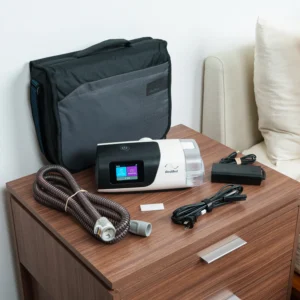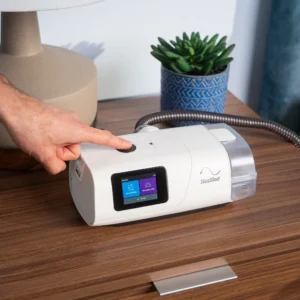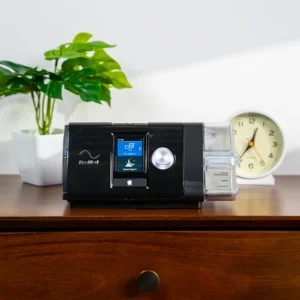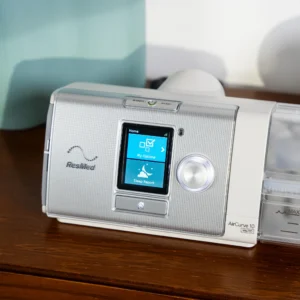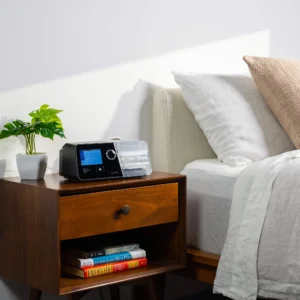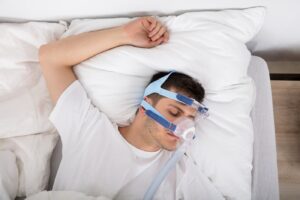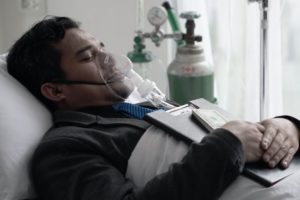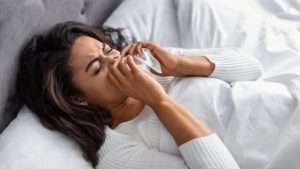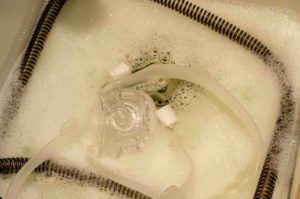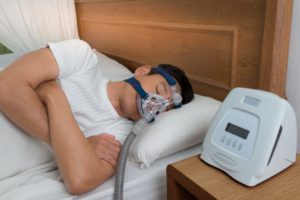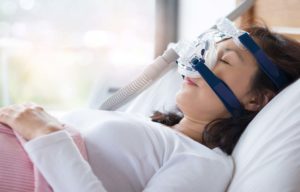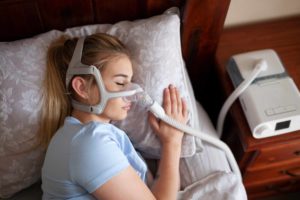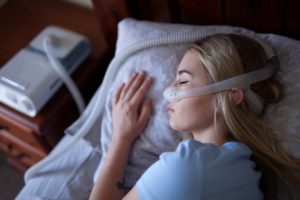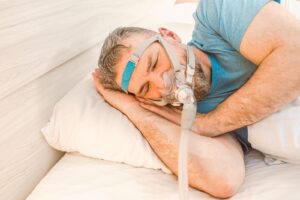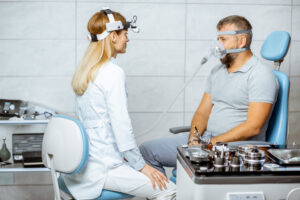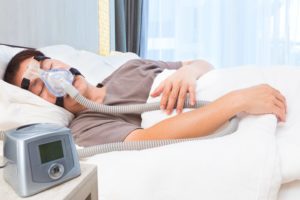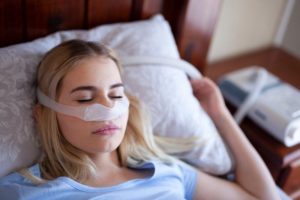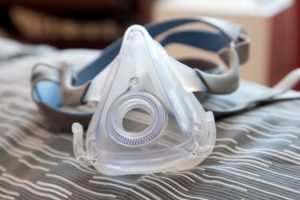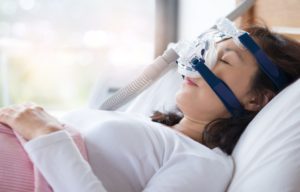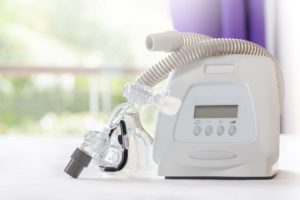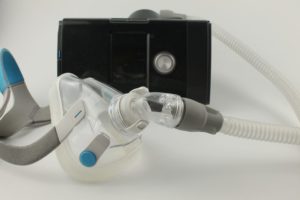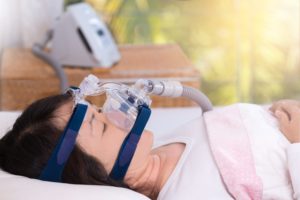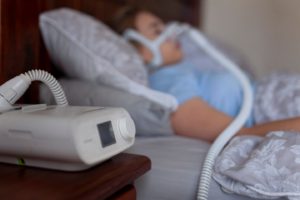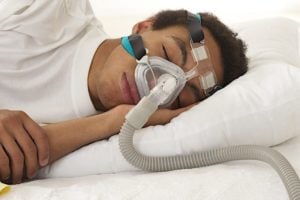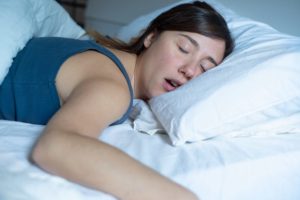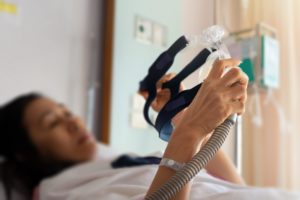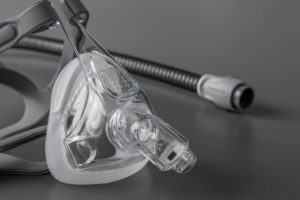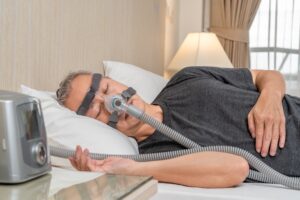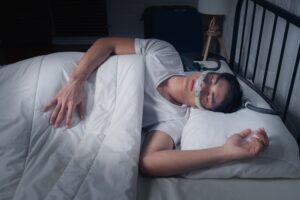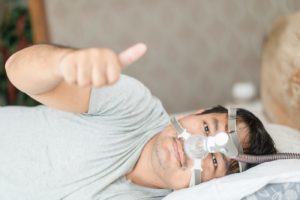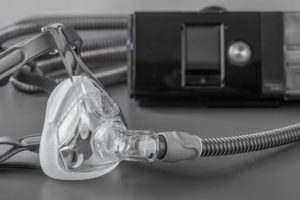When you buy through our links, we may earn a commission. Products or services may be offered by an affiliated entity. Learn more.
Before and After CPAP: How Your Body Changes
- CPAP therapy often leads to improved alertness, reduced daytime sleepiness, and better cognitive function, sometimes after just one night of use.
- CPAP use can help lower blood pressure, reduce cardiovascular strain, and improve metabolic health, including improved insulin sensitivity and glucose regulation.
- Changes in body weight after beginning CPAP are mixed. Some studies report weight gain instead of loss, so CPAP therapy should be paired with lifestyle changes for weight management.
Starting CPAP therapy can lead to noticeable changes in how you feel, sleep, and function—sometimes even after the first night. By preventing the repeated breathing interruptions that come with obstructive sleep apnea (OSA) and fragment your sleep, CPAP helps restore deeper, more restorative rest.
Over time, many people experience more daytime energy, better mood, improved concentration, and meaningful benefits for long-term health. Below, we’ll cover the key changes you may notice before and after starting CPAP therapy and what to expect as your body adjusts.

Have You Been Tested for Sleep Apnea Yet?
Start with our easy, at-home sleep test. It’s stress-free and effective. Get results within a few days.
CPAP and Weight Loss
Obstructive sleep apnea is closely linked to higher body weight, with each 10% weight gain increasing OSA risk sixfold. Studies also suggest that having OSA may cause a person to gain weight.
Because of this connection, some researchers have explored whether CPAP therapy might help people lose weight. However, evidence so far is mixed, and CPAP alone does not reliably lead to weight loss.
Will CPAP Help Me Lose Weight?
While older research has suggested CPAP use could help people lose weight, more recent analyses of dozens of studies have found that weight may actually increase after a person with OSA begins CPAP treatment.
Therefore, people with OSA who are overweight should not rely on CPAP therapy alone to help with weight loss. Instead, experts recommend that people continue other strategies to help reduce body weight.
Does CPAP Cause Weight Gain?
Researchers aren’t entirely sure why treating OSA with a CPAP machine can lead to weight gain. Weight is influenced by a number of factors like diet, exercise, and individual hormone levels, making it difficult to pinpoint whether CPAP therapy is directly linked to weight gain.
However, researchers have theorized several possible causes of weight gain while people are on CPAP therapy.
- Changes in energy usage: Untreated OSA can cause the body to use more energy during sleep due to low oxygen or heightened nervous system activity. . Studies have also found that basal metabolic rate (calories burned at rest) drops after starting CPAP, resulting in weight gain for some people.
- Having high blood sugar: People with diabetes or impaired blood sugar control are more likely to gain weight after starting CPAP, possibly due to shifts in how their bodies respond to insulin.
- Increases in lean body mass: Other studies suggest weight gain after CPAP use could be due to an increase in lean muscle mass, but not body fat, in some people.
How Your Body Changes After CPAP
Once you begin CPAP therapy, your body can undergo a range of noticeable changes as your sleep becomes more restorative and your nighttime breathing stabilizes. Some improvements happen quickly, while others build gradually over weeks or months. Together, these changes reflect the body’s recovery from the strain of untreated sleep apnea.
Increased Alertness
Treating OSA with CPAP therapy has been found to reduce daytime sleepiness and increase alertness. Even one night of CPAP use can lead to improved attention the next day.
Some people with OSA might have residual sleepiness, even after treatment with CPAP therapy. People at the highest risk for residual sleepiness include those with more sleepiness to begin with, younger adults, people who use the CPAP machine for less than four hours a night, and those with depression.
Reduced Symptoms of Depression and Anxiety
Studies show that treating OSA with CPAP can reduce symptoms of anxiety and depression , though these effects may be less impactful in people who also have coronary artery disease.
Although experts aren’t certain about the exact effect OSA has on anxiety and depression, some suggest the low oxygen levels associated with OSA may lead to brain changes that affect mood. This may explain why CPAP therapy improves mental health for some people.
Improved Cardiovascular Health
Research suggests that CPAP therapy may support better cardiovascular health in people with obstructive sleep apnea, although more research is needed. Studies show that CPAP can lower blood pressure—even in people without hypertension—which helps reduce the risk of stroke and heart disease.
Early evidence also indicates that CPAP may decrease nighttime arrhythmias by stabilizing breathing and oxygen levels during sleep. Additionally, several small studies have found that CPAP can improve the heart’s ability to pump blood and may help reduce the risk of heart failure or improve heart function in those already diagnosed.
Reduced Heart Failure Risk and Severity
Both OSA and a more rare type of sleep apnea called central sleep apnea often overlap with heart failure . Generally, OSA contributes to the development of heart failure, while central sleep apnea develops after heart failure is present.
Research shows that treating sleep apnea with CPAP can improve the heart dysfunction often seen in heart failure. CPAP appears to support heart health by improving how the left ventricle functions and by calming nervous system activity that influences blood pressure and heart rate.
Fewer Headaches
OSA can cause a person to wake up with a morning headache, but experts aren’t entirely sure why this is the case. Treating OSA with CPAP has been found to reduce these morning headaches and headaches in general.
Improved Diabetes Symptoms
High blood sugar can cause symptoms like fatigue, blurry vision, frequent urination, increased hunger, and skin infections. While insulin therapy helps manage blood sugar, some people experience insulin resistance, which makes these symptoms harder to control.
Research suggests that treating OSA with CPAP may help reduce insulin resistance by lowering blood sugar levels and improving insulin sensitivity. The idea is that the stress and hormonal changes caused by poor-quality sleep raise blood sugar, and CPAP use helps reverse those effects by restoring more stable, restorative sleep.
Fewer Male Reproductive Issues
While there remain very few studies on this topic, males with OSA may face a greater risk of infertility , as was demonstrated by a large study out of Taiwan.
OSA may play a role in the development of male infertility through many ways, like changes in hormone levels, a build-up of oxygen-containing toxins, insulin resistance, and erectile dysfunction . More research is needed, but studies are starting to show that CPAP and other OSA treatments may help lower the risk of male infertility.
Healthier Pregnancy
Sleep apnea occurs more commonly during pregnancy, and becomes more severe as the pregnancy goes on. Experts suggest sleep apnea with CPAP therapy can improve fetal health.
Pregnant people who had sleep apnea before pregnancy and are already being treated with CPAP therapy may need to have the pressure settings of their machine adjusted during and after pregnancy, since pregnancy can worsen the severity of OSA.
Potential Side Effects of CPAP Therapy
While CPAP is the most effective treatment for obstructive sleep apnea, some people experience side effects as they adjust to nightly use. Many of these issues improve with proper mask fitting, equipment adjustments, or added comfort features.
- Dry nose, mouth, or throat: Pressurized air can dry out the airway, especially in people who breathe through their mouth at night. Adding heated humidification or using a heated tube often reduces dryness and irritation.
- Nasal congestion or runny nose: The airflow can cause nasal congestion, sneezing, or a runny nose. Humidification, nasal saline sprays, or switching to a full-face mask may help.
- Aerophagia (air swallowing): Some people swallow air during CPAP use, leading to bloating, gas, or stomach discomfort. Adjusting pressure settings, enabling ramp mode, or switching to a different PAP device (such as APAP or BiPAP) may help.
- Skin irritation or allergic reactions: Masks, headgear, or silicone cushions can occasionally cause skin irritation. Hypoallergenic mask liners, gentle cleansers, or alternative cushion materials may resolve the issue.
- Feeling claustrophobic: Wearing a mask can cause anxiety or claustrophobic sensations in some users. Practicing with the mask while awake, choosing a minimalist design, or using a nasal pillow mask can ease the transition.
How to Get Started With CPAP Therapy
After your sleep study confirms a diagnosis of obstructive sleep apnea, your doctor or sleep specialist will write a prescription that includes the machine type, pressure settings, and recommended mask style. From there, you can obtain your equipment through a durable medical equipment (DME) supplier or an online retailer.
Once you receive your CPAP machine, take time to familiarize yourself with the device’s features, such as ramp settings, humidification, and mask fit options. A proper fit is essential for both comfort and effective therapy, so try on different mask styles if needed and adjust the headgear until you achieve a good seal without overtightening. It’s also helpful to practice wearing the mask while awake to ease the transition.
During the first few weeks, consistency is key. Wear your CPAP every night (and during naps) to help your body adjust. If you experience discomfort, dryness, air leaks, or trouble tolerating pressure, reach out to your provider or equipment team for guidance. Small adjustments to pressure settings, humidity, or mask type can make a significant difference. With regular use and proper support, most people find CPAP becomes an easy and effective part of their nightly routine.
Frequently Asked Questions
Why do I feel worse after using CPAP?
Some people feel worse during the first few days or weeks of CPAP therapy because their body is adjusting to steady air pressure, a new mask, or improved but unfamiliar sleep patterns. Common issues like mask leaks, nasal congestion, dry mouth, or air swallowing (aerophagia) can also cause discomfort or fragmented sleep.
Most symptoms improve with proper mask fitting, humidification, or small pressure adjustments, so it’s important to discuss any problems with your sleep specialist.
Does CPAP help with snoring?
It can. CPAP is one of the most effective ways to stop snoring caused by obstructive sleep apnea (OSA). Many people notice a significant reduction—or complete elimination—of snoring as soon as they begin consistent CPAP therapy.
However, CPAP is generally prescribed only for people diagnosed with sleep apnea. Insurance providers typically require an official OSA diagnosis before they will cover the cost of a CPAP machine, so it’s not commonly used to treat snoring alone.
What are lifestyle changes for sleep apnea?
Helpful lifestyle changes for managing sleep apnea include maintaining a healthy weight, sleeping on your side instead of your back, avoiding alcohol and sedatives before bedtime, quitting smoking, treating nasal congestion, and getting regular exercise.

Still have questions? Ask our community!
Join our Sleep Care Community — a trusted hub of product specialists, sleep health professionals, and people just like you. Whether you’re searching for the perfect mattress or need expert sleep advice, we’ve got you covered. Get personalized guidance from the experts who know sleep best.
References
16 Sources
-
Kline, L. R. (2022, June 1). Clinical presentation and diagnosis of obstructive sleep apnea in adults. In N. Collop (Ed.). UpToDate.
https://www.uptodate.com/contents/clinical-presentation-and-diagnosis-of-obstructive-sleep-apnea-in-adults -
Drager, L. F., Brunoni, A. R., Jenner, R., Lorenzi-Filho, G., Benseñor, I. M., & Lotufo, P. A. (2015). Effects of CPAP on body weight in patients with obstructive sleep apnoea: A meta-analysis of randomised trials. Thorax, 70(3), 258–264.
https://pubmed.ncbi.nlm.nih.gov/25432944/ -
Chen, B., Drager, L. F., Peker, Y., Vgontzas, A. N., Phillips, C. L., Hoyos, C. M., Salles, G. F., Guo, M., & Li, Y. (2021). Effect of continuous positive airway pressure on weight and local adiposity in adults with obstructive sleep apnea: A meta-analysis. Annals of the American Thoracic Society, 18(10), 1717–1727.
https://pubmed.ncbi.nlm.nih.gov/33740390/ -
Tachikawa, R., Ikeda, K., Minami, T., Matsumoto, T., Hamada, S., Murase, K., Tanizawa, K., Inouchi, M., Oga, T., Akamizu, T., Mishima, M., & Chin, K. (2016). Changes in energy metabolism after continuous positive airway pressure for obstructive sleep apnea. American Journal of Respiratory and Critical Care Medicine, 194(6), 729–738.
https://pubmed.ncbi.nlm.nih.gov/26930227/ -
Djonlagic, I., Guo, M., Matteis, P., Carusona, A., Stickgold, R., & Malhotra, A. (2015). First night of CPAP: Impact on memory consolidation attention and subjective experience. Sleep Medicine, 16(6), 697–702.
https://pubmed.ncbi.nlm.nih.gov/25953301/ -
Pepin, J. L. (2021, April 24). Evaluation and management of residual excessive sleepiness in adults with obstructive sleep apnea. In N. Collop & T. E. Scammell (Eds.). UpToDate.
https://www.uptodate.com/contents/evaluation-and-management-of-residual-excessive-sleepiness-in-adults-with-obstructive-sleep-apnea -
Lee, M. C., Shen, Y. C., Wang, J. H., Li, Y. Y., Li, T. H., Chang, E. T., & Wang, H. M. (2017). Effects of continuous positive airway pressure on anxiety, depression, and major cardiac and cerebro-vascular events in obstructive sleep apnea patients with and without coronary artery disease. Tzu-chi Medical Journal, 29(4), 218–222.
https://pubmed.ncbi.nlm.nih.gov/29296051/ -
Shafazand, S., & Patel, S. R. (2014). Effect of CPAP on blood pressure in patients with obstructive sleep apnea and resistant hypertension. Journal of Clinical Sleep Medicine, 10(3), 341–343.
https://pubmed.ncbi.nlm.nih.gov/24634635/ -
Mehra, R. (2024, May). Obstructive sleep apnea and cardiovascular disease in adults. In N. Collop & G. Finlay (Ed.). UpToDate.
https://www.uptodate.com/contents/obstructive-sleep-apnea-and-cardiovascular-disease-in-adults -
Kato, T., Suda, S., & Kasai, T. (2014). Positive airway pressure therapy for heart failure. World Journal of Cardiology, 6(11), 1175–1191.
https://pubmed.ncbi.nlm.nih.gov/25429330/ -
Johnson, K. G., Ziemba, A. M., & Garb, J. L. (2013). Improvement in headaches with continuous positive airway pressure for obstructive sleep apnea: A retrospective analysis. Headache, 53(2), 333–343.
https://pubmed.ncbi.nlm.nih.gov/22963547/ -
Herth J, Sievi NA, Schmidt F, Kohler M. Effects of continuous positive airway pressure therapy on glucose metabolism in patients with obstructive sleep apnoea and type 2 diabetes: a systematic review and meta-analysis. Eur Respir Rev. 2023;32(169):230083. Published 2023 Sep 6. doi:10.1183/16000617.0083-2023
https://pmc.ncbi.nlm.nih.gov/articles/PMC10481331/ -
Jhuang, Y. H., Chung, C. H., Wang, I. D., Peng, C. K., Meng, E., Chien, W. C., & Chang, P. Y. (2021). Association of obstructive sleep apnea with the risk of male infertility in Taiwan. JAMA Network Open, 4(1), Article e2031846.
https://pubmed.ncbi.nlm.nih.gov/33475753/ -
Kyrkou, K., Alevrakis, E., Baou, K., Alchanatis, M., Poulopoulou, C., Kanopoulos, C.,Vagiakis, E. & Dikeos, D. (2022). Impaired human sexual and erectile function affecting semen quality, in obstructive sleep apnea: A pilot study. Journal of Personalized Medicine, 12(6), 980.
https://pubmed.ncbi.nlm.nih.gov/35743765/ -
Izci Balserak B. (2015). Sleep disordered breathing in pregnancy. Breathe, 11(4), 268–277.
https://pubmed.ncbi.nlm.nih.gov/27064321/ -
Schwab, R. J. (2022, May). Snoring. Merck Manual Consumer Version.
https://www.merckmanuals.com/home/brain,-spinal-cord,-and-nerve-disorders/sleep-disorders/snoring


